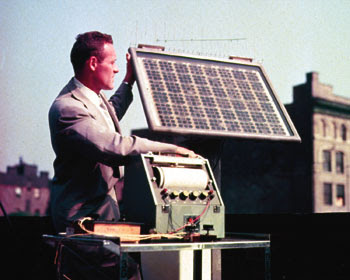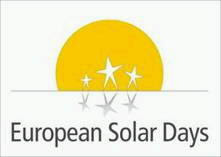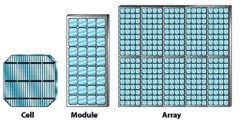1904 - Albert Einstein published his paper on the photoelectric effect (along with a paper on his theory of relativity). Wilhelm Hallwachs makes a semiconductor-junction solar cell (copper and copper oxide).
1914 - The existence of a barrier layer in photovoltaic devices was noted.
1916 - Robert Millikan provided experimental proof of the photoelectric effect.
1918 - Polish scientist Jan Czochralski developed a way to grow single-crystal
silicon.
1921 - Albert Einstein received the Nobel Prize for his theories explaining the photoelectric effect.
1932 - Audobert and Stora discover the photovoltaic effect in Cadmium selenide (CdSe), a photovoltaic material still used today.
1954 - Bell Labs announces the invention of the first modern silicon solar cell. The scientists Gerald Pearson, Daryl Chapin, and Calvin Fuller develop the silicon photovoltaic (PV) cell at Bell Labs—the first solar cell capable of converting enough of the sun’s energy into power to run everyday electrical equipment. Bell Telephone Laboratories produced a silicon solar cell with 4% efficiency and later achieved 11% efficiency. Reporting the Bell discovery, The New York Times praised it as "the beginning of a new era, leading eventually to the realization of harnessing the almost limitless energy of the sun for the uses of civilization".
1959 - Hoffman Electronics creates a 10% efficient commercial solar cell, and introduces the use of a grid contact, reducing the cell's resistance.
1962 - Bell Telephone Laboratories launches the first telecommunications satellite, the Telstar (initial power 14 watts).
1963 - Sharp Corporation succeeds in producing practical silicon PV modules. Japan installed a 242-W PV array on a lighthouse, the world's largest array at that time.
1965 - Peter Glaser conceives the idea of the satellite solar power station.
1973 - The University of Delaware builds “Solar One,” one of the world’s first photovoltaic PV) powered residences. The system is a PV/thermal hybrid.
1980 - At the University of Delaware, the first thin-film solar cell exceeds 10% efficiency using copper sulfide/cadmium sulfide.
1982 - The first, photovoltaic megawatt-scale power station goes on-line in Hisperia, California. It has a 1-megawatt capacity system, developed by ARCO Solar, with modules on 108 dual-axis trackers.
1983 - ARCO Solar dedicates a 6-megawatt photovoltaic substation in central
California. The 120-acre, unmanned facility supplies the Pacific Gas & Electric Company’s utility grid with enough power for 2,000-2,500 homes.
1985 - 20% efficient silicon cell are created by the Centre for Photovoltaic Engineering at the University of New South Wales.
1993 - Pacific Gas & Electric completes installation of the first grid-supported photovoltaic system in Kerman, California. The 500-kilowatt system was the first “distributed power” effort.
1998 - Subhendu Guha, a noted scientist for his pioneering work in amorphous silicon, led the invention of flexible solar shingles, a roofing material and state-of-the-art technology for converting sunlight to electricity.
1999 - Total worldwide installed photovoltaic power reached 1000 megawatts.






